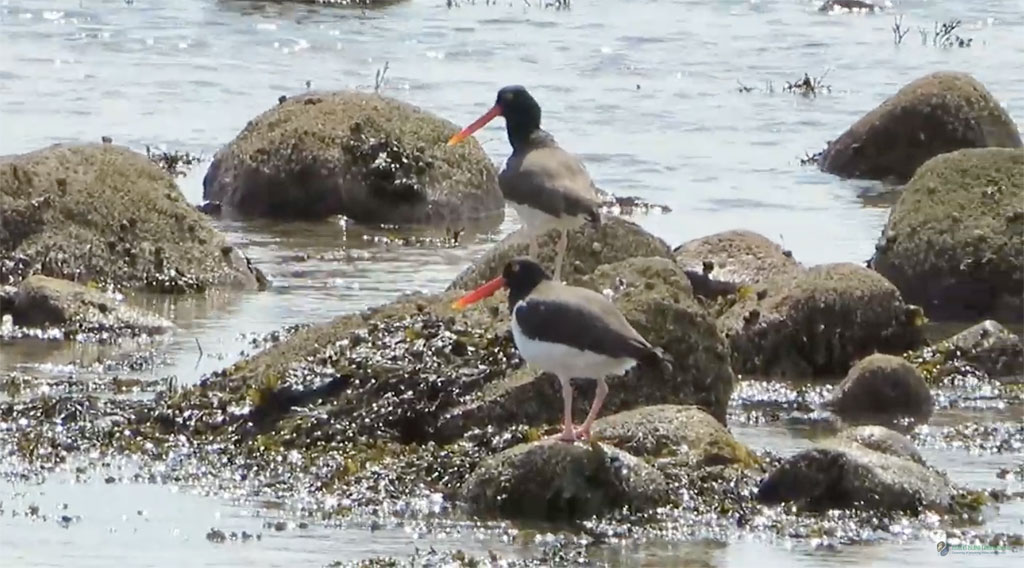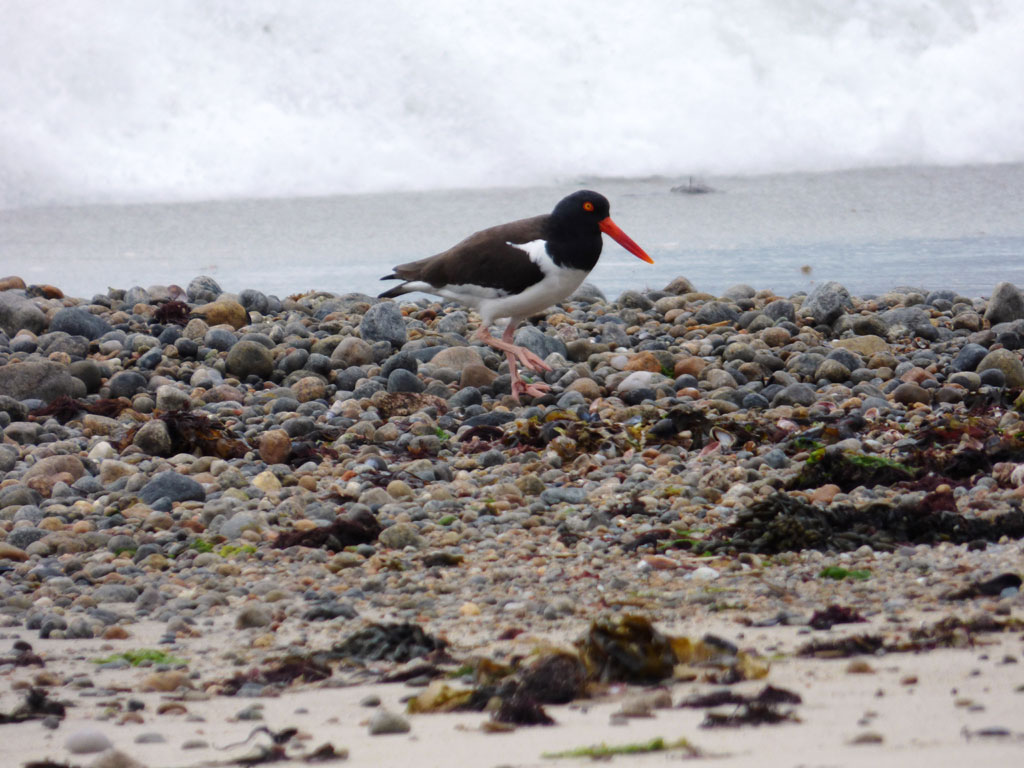
The first pair of American oystercatchers spotted on Stony Beach Mar. 29. Justine Kibbe Photo
Three pairs of American oystercatchers have returned to Fishers Island. FIConservancy Naturalist Justine Kibbe observed the first pair at about 2 p.m. March 29 on Stony Beach in Hay Harbor. She reported the second pair on Sanctuary of Sands, along the Elizabeth Field Runway April 22 and the third pair on Stony Beach April 23.
“I tell young students that there is a great need on-Island to provide safe sanctuary and healthy habitat for dwindling wildlife,” Ms. Kibbe said.
The American oystercatcher, occasionally called the American pied oystercatcher, was originally called the “sea pie”. It was renamed in 1731, when naturalist Mark Catesby observed the bird eating oysters. Oystercatchers feed on crustaceans and mollusks and are able to open crab shells and oysters with their strong red beaks.

One of the second pair of American oystercatchers observed April 22 at Sanctuary of Sands along Elizabeth Field runway. Justine Kibbe Photo

The third pair of American oystercatchers were observed on Stony Beach, Hay Harbor April 23. Justine Kibbe Photo.
Sprung…
Field Notes, From the FieldSpring has…
Fishers Island is “typically” 7-10 days behind mainland Connecticut with its bursting of blooms.
From the Field, Field Note, Justine Kibbe, April 29, 2019
Seaweeds Awash
Field Notes, From the FieldTidal flows and southern storm surge form knee-high berms of kelp and seaweeds, sculpted into “river beds and canyons”.
This thick and abundant wrack line promises to create wonderful “photo opportunities”—meeting various returning shore birds within Sanctuary of Sands, Fishers Island.
From the Field, Field Note, Justine Kibbe, April 29, 2019
Morning’s Watch
Field Notes, From the FieldRed-tailed hawk keeps watch while holding the fort as “pesky” fish crows sound their alarm…
Fort Wright Parade Grounds, Fishers Island
From the Field, Field Note, Justine Kibbe, April 28, 2019
Caterpillars of the Community
Field Notes, From the FieldEastern tent caterpillars have begun to set up camp here on Fishers Island. While these hairy caterpillar, moth larvae are considered pests, NOT so to the Orioles, Jays, Chickadees and Nuthatches!
Keep your eyes peeled to watch even frogs, bats and squirrels help “control” these squirmy spring “residents”.
*South Beach Road.
From the Field, Field Note, Justine Kibbe, April 29, 2019
Join the Chorus
Field Notes, From the FieldTurtle Reunion
Field Notes, From the FieldEastern painted turtles enjoyed their day at the beach, enveloping South Beach Pond on this sunny afternoon.
*counted nearly 50!
From the Field, Field Note, Justine Kibbe, April 24, 2019
Housing Renovation
Field Notes, From the FieldPond Perfect Day
Field Notes, From the FieldAmerican Oystercatchers Return
Field Notes, From the Field, NewsThe first pair of American oystercatchers spotted on Stony Beach Mar. 29. Justine Kibbe Photo
Three pairs of American oystercatchers have returned to Fishers Island. FIConservancy Naturalist Justine Kibbe observed the first pair at about 2 p.m. March 29 on Stony Beach in Hay Harbor. She reported the second pair on Sanctuary of Sands, along the Elizabeth Field Runway April 22 and the third pair on Stony Beach April 23.
“I tell young students that there is a great need on-Island to provide safe sanctuary and healthy habitat for dwindling wildlife,” Ms. Kibbe said.
The American oystercatcher, occasionally called the American pied oystercatcher, was originally called the “sea pie”. It was renamed in 1731, when naturalist Mark Catesby observed the bird eating oysters. Oystercatchers feed on crustaceans and mollusks and are able to open crab shells and oysters with their strong red beaks.
One of the second pair of American oystercatchers observed April 22 at Sanctuary of Sands along Elizabeth Field runway. Justine Kibbe Photo
The third pair of American oystercatchers were observed on Stony Beach, Hay Harbor April 23. Justine Kibbe Photo.
Big Stony Residents Are Back
Field Notes, From the Field